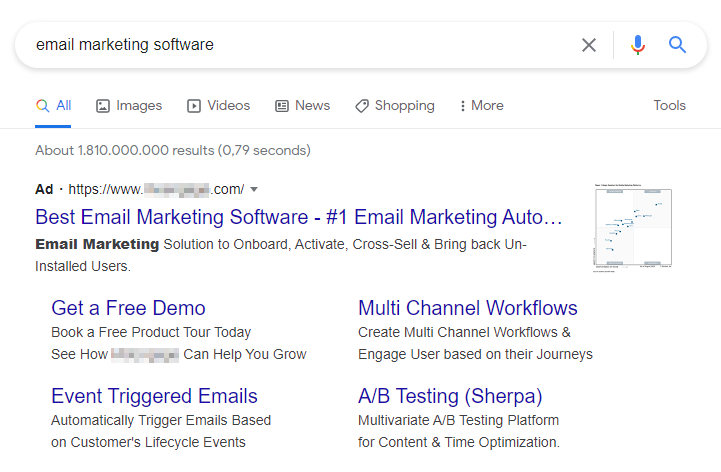Did you know that trustworthiness can be communicated to your audience before they even enter your website? It goes without saying that first impressions are really important and Google Ads often provide that first touch point between your online shop and a potential new customer. Today, we’re going to look at how to build trustworthiness through Google Ads and how Google ad extensions are the key to that.
Trust in e-commerce
Before we get into it, let’s talk a little bit about trust.
Trust is an abstract concept in real-life. People often rely on their instincts to determine if someone or something is trustworthy. When it comes to online shopping, things are a bit different. Yes, consumers still rely on their instincts to some degree, but there are a handful of things that they look to in order to assess a shop’s trustworthiness.
Online reviews
The first obvious way to assess a shop’s trustworthiness would be customer reviews. We all read them and they are basically a must for any shop hoping to succeed. What’s important to remember when it comes to online reviews is that they can generally be split into two categories: shop reviews and product reviews.
Product reviews naturally focus on the product that is sold while shop reviews focus on the service provided by the shop. Sometimes, these two types of reviews overlap in content, but it’s important for you as a shop owner to collect both of them.
Why? Because Google separates the two and uses the two types of reviews in different ways. For example, Google Shopping ads might use both shop reviews and product reviews. However, classic text ads just use shop reviews in their ratings.
In either case, it’s recommended to collect both product reviews and shop reviews for your online business.
Other elements on your website
Although online reviews are the obvious “trust-builder”, it’s important to realize that many things can factor into your perceived trustworthiness, especially once the user is actually browsing your website. We’ll touch on some of these factors throughout this article, but it’s important to keep in mind that a lot of trust is earned through good design and user experiences.
Make sure that your website is easy to navigate and structured properly. If users can’t find their way around your shop easily, they will exit your website quickly. Naturally, we won’t cover all the basics about building trust for your online shop, but it was worth mentioning and always good to keep these things in mind.
In this article, we’ll be focusing on building trust through Google Ads, so let’s get to it!
Google Ads
Google Ads are a really effective way to drive traffic to your website. By sending out the right message and focusing on the right keywords, you can really inspire a lot of people to visit your shop. Many companies have seen growth thanks to Google Ads and Google has grown a lot thanks to them as well. It’s been a win-win situation for Google and their clients up until now.
Over the years, Google Ads have expanded their reach throughout the Google universe. However, the most effective ads are still the ones that have been there all along: the text ads that appear at the top of search results. Not only have Google Ads expanded, but they’ve evolved.
Ad extensions
A big part of this evolution has come in the form of ad extensions. What are Google ad extensions? They are options offered in a Google Ad that give companies the possibility to show off more information about themselves and hopefully inspire internet users to click on their ads even more.
Using ad extensions is a great way to grab people’s attention, but they can also inspire trust. In the example below, the Google Ad is accompanied by a Google ad extension called “seller ratings” as well as sitelink extensions (yes, you can display multiple ad extensions at once).
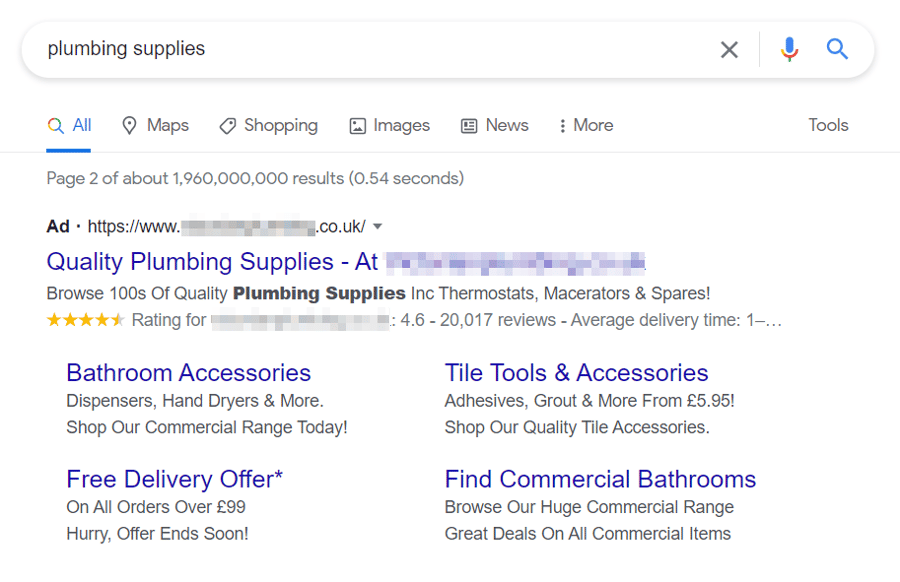
Let’s look at some of the best ad extensions for building trust in your Google ads!
Sitelink extensions
Sitelink extensions is an ad extension you can opt into. Essentially, what sitelink extensions do is provide additional links to your ad, which lead to different pages on your website. Here is an example:

The idea here is to provide more transparency to your ad. By letting the customer know what some of your most important pages are, they have a better overview of your shop before they enter it. This automatically builds a certain level of trust.
However, choosing the right sitelinks to display also plays a role. In the example above, seeing “Hours” lets shoppers know you are a physical shop as well, which automatically builds trust. A section for “Healthy diets” means you create content and offer users more value than just products to sell; another trust-builder!
Callout extensions
Callout extensions are a great option as well. Callout extensions are essentially little phrases and messages that you want to highlight in your ad. They appear at the bottom of the ad. In the example below, the text found all the way at the bottom (e.g. Free Shipping, 24-7 Customer Service, etc.) is from the callout extension.

As you can see, you can highlight a lot of different things here that can motivate your target audience to visit your page. Take this opportunity to build trust as well. By highlighting your customer service as an example, you would definitely be communicating trustworthiness.
There are plenty of ways to build trust through these callout extensions. For example, you could highlight any kind of guarantees you offer. Does your shop offer free returns? Call it out! Do you offer free consultations? Call it out!
Call extensions
Call extensions are pretty much self-explanatory. These call extensions (not to be confused with callout extensions) offer users the ability to call the business in the ad with a simple click. This can be a great option, particularly for local businesses and for users on mobile devices. In the example below, these Google Ads appear at the very top of the search results. Hovering over the business reveals the clickable phone number.
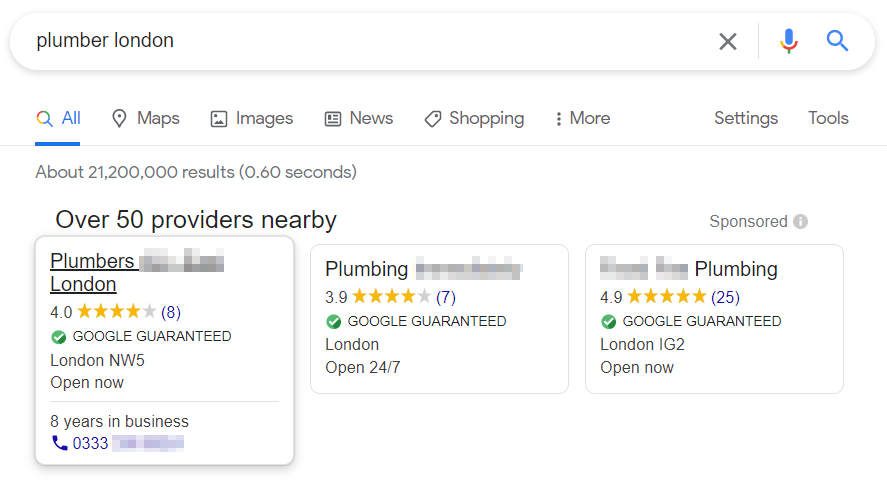
The good news is that a click on a phone number costs the same as a click elsewhere on the ad. A phone call is much easier to convert compared to a normal landing page. If you offer special services like plumbing or even pizza delivery, this can be a great tool for getting new leads/customers.
Providing a regular or virtual phone number can build trust for a few reasons. First of all, for many consumers, it proves you have a physical business with real people there. Secondly, it gives potential customers the feeling that someone is there to help them. It’s the same reason you should make your phone number easily accessible throughout your website.
Whether or not people use it is one thing, but simply seeing it there can be comforting in and of itself.
Location extension
Location extensions are very useful in a similar way to call extensions in that local businesses can benefit the most from this feature. As you might have guessed, the objective of these ads is to get people to visit your local business. They show your ad with your address, a map to your location, or the distance to your business. In some cases, your phone number will appear
.
In the example below, the desktop version of the search results shows the street address at the bottom of the ad.

There’s not much more to say about this that hasn’t already been said about the previous ad extensions: showing you have a physical location builds trust with users. If they know there is a shop with real people they feel much more secure about completing a purchase.
Price extensions
Price extensions is another ad extension that gives more transparency to your ad, thus building more trust (as well as more clicks). Google does a good job naming all these ad extensions because, as you have probably figured out, this one is all about showing your prices in your text ads.
By showing your prices, you are being upfront with your target audience. Along with a competitive pricing strategy, these kinds of ads can definitely lead to more traffic to your site. If you work in a specific niche, you can create different ad groups that target really specific keywords. Your price extensions should complement the keywords you target.
In the example below, you can see that in the second ad, they show what their specific services cost.
Although this might seem like it’s only well-suited for local businesses, it could make sense for a niche shop that has a limited product offering or just a campaign for a certain product category.
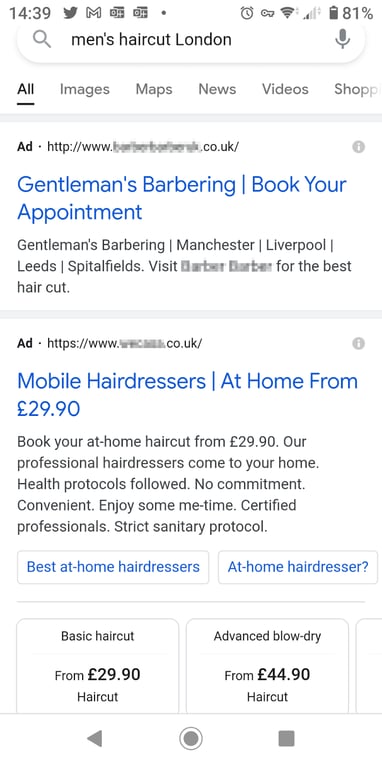
Seller ratings extensions
Last, but definitely not least, are seller ratings ad extensions. As we mentioned towards the beginning of this article, reviews are one of the ultimate trust-builders for online shops. The power of social proof paired with the reach of Google Ads can make for a real traffic-booster.
You’ve most definitely seen them before, but in case you’re unsure, here is an example of what a Google Ad with a seller ratings extension looks like (or check out the ad at the top of this article again):
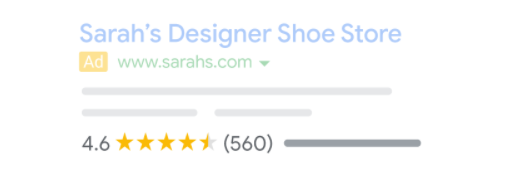
As you can see, the star-ratings you’ve earned appear at the bottom of your ad along with the number of reviews collected. The ratings you see in these types of ads are based on the shop reviews that you collect (not product reviews).
There are a few criteria that need to be met in order to display these reviews. For starters, these star-ratings are displayed on a country-by-country basis. Google needs to collect enough unique reviews (in the country you want to display the ads) across Google Customer Reviews or third-party review partners in order to calculate a seller rating. For most businesses, this threshold is 100 reviews in the past 12 months.
Also, it’s important to note that “third-party review partners” are limited to an exclusive list of review providers (check the link at the top of this section to see the full list).
In addition to the criteria mentioned above, the shop must also:
- have a composite rating of 3.5 stars or higher
- The URL in the ad must match the domain of the collected reviews
Remember, the above-mentioned criteria only applies to the classic text ads. However, ratings appear throughout Google for both product and shop reviews on different Google platforms (e.g. Google Maps, Google Shopping, etc.). Trusted Shops, one of the Google-approved reviews providers, has actually compiled a great overview of all the places throughout Google where stars appear and what the requirements are for getting them to appear there.
According to Google, ads that show star-ratings can boost click-through rates (CTRs) by up to 17%. If you’ve worked with Google before, then you know how a better CTR can lead to cheaper ads. It’s clear that showing star-ratings in your ads can improve your ad campaigns’ performance.
Conclusion
As you can see, there is a lot you can do to build trust with your Google Ads. Although these tips may seem quite subtle, it’s important to remember that consumers look at those little details, whether consciously or not, and judge your trustworthiness to a certain degree before they even enter your site.
